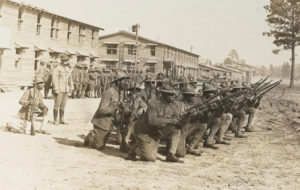Aug. 30 lecture to tell story of 371st Infantry Regiment in the First World War
August 14, 2019The 371st Infantry Regiment of the U.S. Army, formed in South Carolina in 1917, was a segregated unit typical of its time, with black enlisted men and white officers.
But when it arrived in France to fight in the spring of 1918, it found itself “segregated” in another way: It was split off from the American Expeditionary Forces altogether, and attached to the French Army instead.
For that reason it has been termed the “Orphan Brigade.” On Friday, Aug. 30, at the South Carolina Confederate Relic Room and Military Museum in Columbia, Harris Bailey will speak about the regiment’s experiences in the First World War. The lecture is titled, “The Orphan Brigade: the 371st Odyssey in World War I.”
The regiment was formed at Camp Jackson in October 1917, made up primarily of African-American draftees from South Carolina. Its formation was delayed somewhat by the need to get the cotton crop in in the face of a labor shortage. It was of one of twelve “colored” regiments created by the War Department.
The unit headed to France the following April, with its officers and men believing they would fight as part of the U.S. 93rd Infantry Division.
They arrived in the middle of the night at the place where they were told to go, and there was no one there. Only after returning to the railroad depot and making a phone call did the regiment’s commanding officer learn what had happened. As Bailey relates it, headquarters essentially said, “Oh, you didn’t know you had been transferred to the French Army?”
At that point, the unit was required to turn in all its gear, after which they were issued French equipment and required to undergo French training, reflecting a “totally different approach to warfare.”
This setback didn’t prevent the men of the 371st from distinguishing themselves in combat as part of the French 157th Infantry Division. They fought in the Argonne, and were on the front line at Verdun. As a unit, they were awarded the French Croix de Guerre.
Many years later, a member of the 371st – Freddie Stowers – received the Congressional Medal of Honor posthumously for his heroic actions in the assault on Côte 188 on Sept. 28, 1918. In addition, one officer of the 371st received the French Légion d’Honneur, and 22 officers and men were awarded the Distinguished Service Cross.
Harris Bailey Jr. is a native of Greenwood, S.C. He graduated from Lander University with a bachelor’s degree in political science, and from Western Kentucky University with a master’s in public administration. He is the author of the journal article, “The Splendid Little Forgotten War: The Mobilization of South Carolina for the War with Spain,” and the co-author of Our Ancestors, Our Stories, a book about the African-American experience in Edgefield County, S.C.
His free noon lecture on the 30th is part of the museum’s monthly Lunch and Learn series, and is open to the public.
About the South Carolina Confederate Relic Room and Military Museum
Founded in 1896, the South Carolina Confederate Relic Room and Military Museum is an accredited museum focusing on South Carolina’s distinguished martial tradition through the Revolutionary War, Mexican War, Civil War, Spanish-American War, World Wars I and II, Vietnam, the War on Terror, and other American conflicts. It serves as the state’s military history museum by collecting, preserving, and exhibiting South Carolina’s military heritage from the colonial era to the present, and by providing superior educational experiences and programming. It is located at 301 Gervais St. in Columbia, sharing the Columbia Mills building with the State Museum. For more information, go to https://crr.sc.gov/.

















